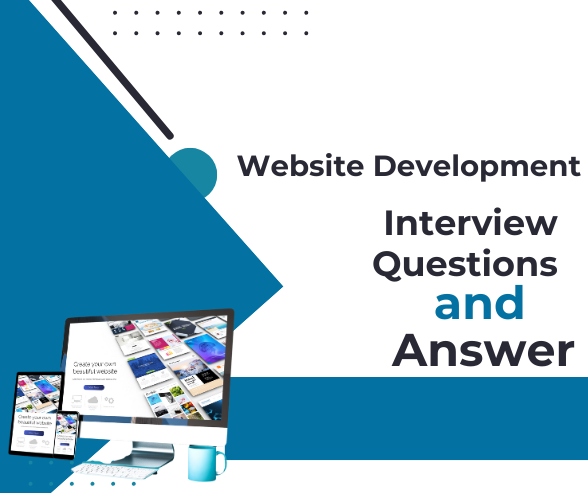Website Development Interview Question And Answer
Website Development Interview Question And Answer
1. What Is Website Development?
Website development is the process of creating, designing, and maintaining a website using technologies like HTML, CSS, JavaScript, and backend languages.
2. What Are the Main Types of Websites?
- Static Websites – Fixed content, no user interaction.
- Dynamic Websites – Uses a database, updates in real-time.
- E-Commerce Websites – Online stores (e.g., Amazon).
- Blog Websites – Content-focused platforms.
3. What Is the Difference Between Frontend and Backend Development?
Frontend – The part of the website users interact with (HTML, CSS, JavaScript).
Backend – The server-side functionality (PHP, Node.js, databases).
4. What Are the Core Technologies Used in Website Development?
- HTML – Structure of the webpage.
- CSS – Styling and layout.
- JavaScript – Adds interactivity.
- Backend Languages – PHP, Python, Node.js.
5. What Is a CMS, and Why Is It Used?
A Content Management System (CMS) is a platform that allows users to build websites without coding.
Examples: WordPress, Joomla, Drupal.
6. What Is the Difference Between Responsive and Adaptive Web Design?
- Responsive Design – Adjusts to any screen size dynamically.
- Adaptive Design – Uses fixed layouts based on screen sizes.
7. What Is SEO in Website Development?
SEO (Search Engine Optimization) improves website ranking in search engines by using:
- Optimized content & keywords.
- Fast page loading speed.
- Mobile responsiveness.
8. What Is JavaScript Framework, and Which Are the Most Popular?
A JavaScript framework simplifies development by providing pre-built functions.
Examples:
- React.js – Used for building user interfaces.
- Vue.js – Lightweight & flexible.
- Angular.js – Developed by Google, used for large applications.
9. What Is API in Web Development?
An API (Application Programming Interface) allows different applications to communicate.
Example: Google Maps API for location services.
10. What Is the Importance of Website Security?
Website security protects from hacking, malware, and data breaches. Best practices:
- Use SSL certificates.
- Enable firewalls.
- Keep software & plugins updated.
11. What Is a Database in Web Development?
A database stores and manages website data. Popular databases:
- MySQL – Open-source, commonly used with PHP.
- MongoDB – NoSQL, used for scalable applications.
- PostgreSQL – Advanced relational database.
12. What Is Lazy Loading?
Lazy loading defers loading images & videos until needed, improving page speed.
13. What Is Caching in Web Development?
Caching stores website data temporarily to reduce server load and improve speed.
14. How Do You Optimize a Website for Mobile Users?
- Use responsive design.
- Enable AMP (Accelerated Mobile Pages).
- Test on Google Mobile-Friendly Test.
15. What Are the Best Code Editors for Web Development?
- VS Code – Lightweight and powerful.
- Sublime Text – Fast and customizable.
- Atom – Open-source and developer-friendly.
16. What Are the Best Frameworks for Backend Development?
- Laravel (PHP) – Easy-to-use PHP framework.
- Django (Python) – Secure & scalable.
- Node.js (JavaScript) – For high-performance applications.
17. How Do You Track Website Traffic and Performance?
- Use Google Analytics for visitor insights.
- Check Google Search Console for SEO issues.
- Use Heatmaps (Hotjar, Crazy Egg) to analyze user behavior.
18. What Is a Progressive Web App (PWA)?
A PWA is a web app that works offline and behaves like a native mobile app.
19. What Is the Future of Website Development?
- AI-powered websites with chatbots & automation.
- Voice search optimization for smart devices.
- Headless CMS for more flexibility in development.
20. What Is a Full-Stack Developer?
A full-stack developer works on both frontend and backend of a website. They use:
- Frontend: HTML, CSS, JavaScript (React, Angular, Vue.js).
- Backend: PHP, Python, Node.js, Ruby on Rails.
- Databases: MySQL, MongoDB, PostgreSQL.
21. How Do You Debug a Website That Is Not Loading?
- Check browser console (F12 > Console) for errors.
- Verify server logs and error logs.
- Test with different browsers & devices.
- Disable plugins or extensions that may be causing issues.
22. What Is a 404 Error and How Do You Fix It?
A 404 error means the page is missing or deleted. Solutions:
- Redirect the broken URL using 301 redirection.
- Check for incorrect links in the website.
- Restore the missing page if deleted by mistake.
23. What Is a Staging Environment?
A staging environment is a test site where developers can check updates before making them live.
- Compress images
- Use a caching plugin
- Minify CSS and JavaScript
- Use a Content Delivery Network (CDN)
24. What Is Mobile-First Indexing?
Google indexes and ranks websites based on their mobile version first.
25. What Are Core Web Vitals?
Google’s ranking factors that measure user experience:
- LCP (Largest Contentful Paint) – Loading speed
- FID (First Input Delay) – Interactivity
- CLS (Cumulative Layout Shift) – Visual stability
26. How Can You Fix Broken Links?
Use tools like Google Search Console or Ahrefs to find broken links and redirect them using a 301 redirect.
27. What Is Google My Business (GMB)?
Google My Business is a free tool that allows businesses to appear in local search results and Google Maps.
28. How Do You Optimize Google My Business?
- Add accurate business details
- Post updates regularly
- Get customer reviews
- Add photos & services
29. What Is NAP Consistency?
NAP (Name, Address, Phone Number) consistency means having the same business details across all online directories.
30. How Do You Rank in Local SEO?
- Optimize Google My Business
- Get local backlinks
- Use location-specific keywords
31. What Is Citation in Local SEO?
A citation is an online mention of your business (NAP) on directories like Yelp, Yellow Pages, etc.
32. What Are the Best SEO Tools?
- Google Search Console
- Google Analytics
- SEMrush
- Ahrefs
33. What Is Google’s Panda Algorithm?
Google Panda penalizes low-quality, thin, or duplicate content.
34. What Is Google’s Penguin Algorithm?
Penguin penalizes spammy backlinks and over-optimized anchor text.
35. What Is Google’s Hummingbird Algorithm?
Hummingbird improves semantic search and natural language understanding.
36. What Is Google’s E-A-T?
E-A-T stands for Expertise, Authoritativeness, and Trustworthiness—important for ranking quality content.
37. What Is Voice Search Optimization?
Optimizing content for voice searches using conversational and long-tail keywords.
38. How Do You Recover From a Google Penalty?
- Identify the issue in Google Search Console.
- Remove spammy backlinks.
- Improve content quality.
39. What Is Link Juice?
Link juice is the SEO value passed from one page to another through backlinks.
40. How Do You Perform a Site Audit?
Use tools like Screaming Frog, SEMrush, or Ahrefs to check:
- Broken links
- Page speed
- Duplicate content
- Indexing issues
41. What Is Mobile SEO?
Mobile SEO ensures that a website is optimized for mobile users by improving:
- Mobile-friendly design (responsive layout)
- Fast page load speed
- Proper viewport settings
42. How Does Google Search Console Help in SEO?
Google Search Console provides insights into:
- Indexing issues
- Crawl errors
- Backlink reports
- Keyword performance
43. What Is Robots.txt?
The robots.txt file guides search engines on which pages to crawl or avoid.
Example: Blocking Search Engines from Crawling an Admin Page
User-agent: *
Disallow: /admin/
44. How Do You Fix a Website That Is Not Indexing?
- Check robots.txt to ensure pages are not blocked.
- Submit sitemap.xml in Google Search Console.
- Ensure pages are not set to “noindex” in meta tags.
- Improve internal linking.
45. What Are HTTP and HTTPS?
- HTTP (Hyper Text Transfer Protocol) – Not encrypted.
- HTTPS (Secure HTTP) – Uses SSL encryption, improving security & SEO.
46. How Do You Migrate a Website Without Losing SEO?
- Set up 301 redirects from old URLs to new ones.
- Update internal links.
- Submit the new sitemap in Google Search Console.
47. How Is AI Changing SEO?
AI tools (like ChatGPT, Google Gemini) improve content generation.
Google’s RankBrain & BERT use AI for better search understanding.
48. What Is Google RankBrain?
RankBrain is Google’s AI algorithm that understands search intent better.
49. What Is Google MUM?
Google MUM (Multitask Unified Model) is an AI algorithm that:
Understands multiple languages.
Processes text, images, and videos for better search results.
50. How Can AI Be Used for Keyword Research?
AI tools like Surfer SEO, Clearscope, and Frase analyze search trends and suggest high-ranking keywords.
51. How Do You Measure SEO Performance?
Use:
- Google Analytics (traffic, bounce rate, conversions).
- Google Search Console (clicks, impressions, CTR).
- Ahrefs/SEMrush (backlinks, keyword rankings).
52. What Is Bounce Rate?
Bounce rate is the percentage of visitors who leave without interacting with the page.
53. What Is Dwell Time?
Dwell time is the time a user spends on a page before returning to search results.
54. What Is Click-Through Rate (CTR)?
CTR = (Clicks ÷ Impressions) × 100
Example:
If 100 people see your page in search results and 10 click on it, your CTR is 10%.
55. How Do You Improve CTR?
- Use compelling meta titles & descriptions.
- Add numbers or brackets (e.g., “Top 10 SEO Tricks [2025]”).
- Use schema markup for rich snippets.
56. How Would You Rank a New Website?
- Keyword Research – Find low-competition keywords.
- Technical SEO – Ensure fast speed, mobile-friendliness.
- Content Strategy – Publish high-quality articles.
- Backlinks – Guest posts, outreach, citations.
57. What Would You Do If Your Website Traffic Dropped Suddenly?
- Check Google Search Console for penalties.
- Analyze Google algorithm updates.
- Fix broken backlinks and update old content.
58. What Is a 301 Redirect?
A 301 redirect permanently moves a page to a new URL.
Example (in .htaccess file):
Redirect 301 /old-page/ https://example.com/new-page/
59. What Is a 404 Error? How to Fix It?
A 404 error occurs when a page is not found. Fix it by:
- Redirecting broken URLs.
- Restoring missing pages.
60. What Are White Hat and Black Hat SEO?
- White Hat SEO – Ethical methods (content, quality backlinks).
- Black Hat SEO – Unethical methods (keyword stuffing, spammy links).
61. What Is the Skyscraper Technique?
- Find high-ranking content in your niche.
- Create a better version of it.
- Outreach to websites linking to the old content.
62. How Do You Build High-Quality Backlinks?
- Guest Blogging
- Broken Link Building
- HARO (Help a Reporter Out)
- Influencer Outreach
63. What Is Anchor Text in SEO?
Anchor text is the clickable text in a hyperlink.
<a href=”https://example.com”>Best SEO Guide</a>
64. How Many Backlinks Does a Page Need to Rank?
There is no fixed number. Quality is more important than quantity.
65. How Do You Rank Higher in Google Maps?
- Optimize Google My Business.
- Get local citations.
- Earn positive reviews.
66. What Is Geotagging in SEO?
Adding location data to images and content to rank in local searches.
67. How Important Are Reviews for Local SEO?
Positive reviews boost local rankings and conversions.
68. Will SEO Still Be Important in 2025?
Yes, but voice search, AI, and user experience will play a bigger role.
69. What Are Web Stories in SEO?
Short, mobile-friendly visual stories that appear in Google Discover.
70. How Will Video SEO Impact Rankings?
Optimized YouTube & video content will appear in search results more often.
71. How Do You Submit a Sitemap to Google?
- Go to Google Search Console.
- Click on Sitemaps.
- Enter the sitemap URL (e.g., https://example.com/sitemap.xml).
- Click Submit.
72. What Is the Difference Between a Static and a Dynamic URL?
- Static URL – Remains the same (e.g., example.com/about-us).
- Dynamic URL – Changes based on parameters (e.g., example.com/page?id=123).
73. What Is Page Speed Optimization?
Page speed optimization improves website loading time using:
- Image compression (WebP, JPEG optimization)
- Minification of CSS, JavaScript, HTML
- Using a Content Delivery Network (CDN)
74. What Is Core Web Vitals?
Google’s Core Web Vitals measure:
- Largest Contentful Paint (LCP) – Page load speed.
- First Input Delay (FID) – Interactivity speed.
- Cumulative Layout Shift (CLS) – Visual stability.
75. How Do You Improve Core Web Vitals?
- Reduce server response time.
- Optimize images & lazy load them.
- Minimize CSS & JavaScript blocking time.
76. What Is the Difference Between Crawling and Indexing?
- Crawling – Search engines scan pages.
- Indexing – Crawled pages are stored in Google’s database.
77. What Is a Canonical Tag?
A canonical tag (rel=”canonical”) prevents duplicate content issues by telling search engines which page is the original version.
<link rel=”canonical” href=”https://example.com/original-page/”>
78. What Is Hreflang Tag?
Hreflang tags help Google serve the correct language version of a webpage to users.
Example for English & Spanish versions:
<link rel=”alternate” hreflang=”en” href=”https://example.com/en/”>
<link rel=”alternate” hreflang=”es” href=”https://example.com/es/”>
79. How Will Voice Search Impact SEO?
- More conversational, long-tail keywords.
- Focus on FAQs & featured snippets.
- Optimize for “Near Me” searches.
80. What Is Google Search Generative Experience (SGE)?
SGE is Google’s AI-powered search, providing direct AI answers in results.
81. What Is Entity-Based SEO?
Google now focuses on entities (people, places, things) rather than just keywords.
Example: If you search for “Elon Musk,” Google recognizes him as an entity, not just words.
82. What Is E-E-A-T?
E-E-A-T stands for:
- Experience
- Expertise
- Authoritativeness
- Trustworthiness
- Google ranks pages higher based on real experience & credibility.
83. What Is Google Discover?
Google Discover shows personalized content based on user interests & browsing habits.
84. What Are Multimodal Searches?
Multimodal searches allow users to search using text, images, and voice together (e.g., Google Lens).
85. What Is the Future of SEO?
SEO will focus on:
- AI-generated content & ranking algorithms.
- Zero-click searches & featured snippets.
- Voice & video search optimization.








